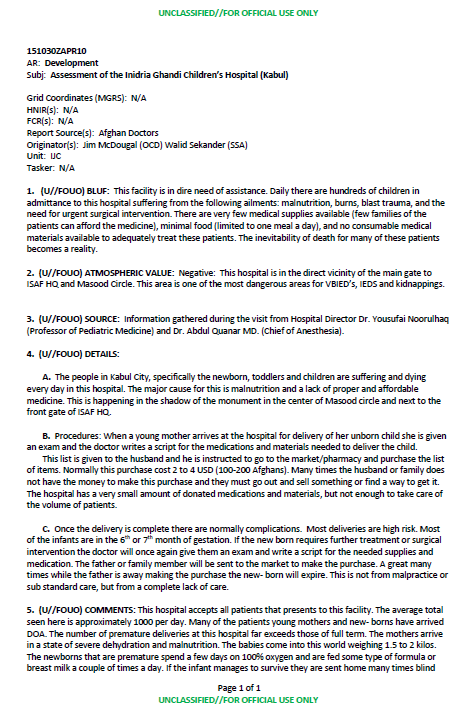 ISAF Information Dominance Centre
ISAF Information Dominance Centre
- 3 pages
- For Official Use Only
- April 10, 2010
1. (U//FOUO) BLUF: This facility is in dire need of assistance. Daily there are hundreds of children in admittance to this hospital suffering from the following ailments: malnutrition, burns, blast trauma, and the need for urgent surgical intervention. There are very few medical supplies available (few families of the patients can afford the medicine), minimal food (limited to one meal a day), and no consumable medical materials available to adequately treat these patients. The inevitability of death for many of these patients becomes a reality.
2. (U//FOUO) ATMOSPHERIC VALUE: Negative: This hospital is in the direct vicinity of the main gate to ISAF HQ and Masood Circle. This area is one of the most dangerous areas for VBIED’s, IEDS and kidnappings.
3. (U//FOUO) SOURCE: Information gathered during the visit from Hospital Director Dr. Yousufai Noorulhaq (Professor of Pediatric Medicine) and Dr. Abdul Quanar MD. (Chief of Anesthesia).
4. (U//FOUO) DETAILS: A. The people in Kabul City, specifically the newborn, toddlers and children are suffering and dying every day in this hospital. The major cause for this is malnutrition and a lack of proper and affordable medicine. This is happening in the shadow of the monument in the center of Masood circle and next to the front gate of ISAF HQ. B. Procedures: When a young mother arrives at the hospital for delivery of her unborn child she is given an exam and the doctor writes a script for the medications and materials needed to deliver the child. This list is given to the husband and he is instructed to go to the market/pharmacy and purchase the list of items. Normally this purchase cost 2 to 4 USD (100-200 Afghans). Many times the husband or family does not have the money to make this purchase and they must go out and sell something or find a way to get it. The hospital has a very small amount of donated medications and materials, but not enough to take care of the volume of patients. C. Once the delivery is complete there are normally complications. Most deliveries are high risk. Most of the infants are in the 6th or 7th month of gestation. If the new born requires further treatment or surgical intervention the doctor will once again give them an exam and write a script for the needed supplies and medication. The father or family member will be sent to the market to make the purchase. A great many times while the father is away making the purchase the new- born will expire. This is not from malpractice or sub standard care, but from a complete lack of care.
5. (U//FOUO) COMMENTS: This hospital accepts all patients that presents to this facility. The average total seen here is approximately 1000 per day. Many of the patients young mothers and new- borns have arrived DOA. The number of premature deliveries at this hospital far exceeds those of full term. The mothers arrive in a state of severe dehydration and malnutrition. The babies come into this world weighing 1.5 to 2 kilos. The newborns that are premature spend a few days on 100% oxygen and are fed some type of formula or breast milk a couple of times a day. If the infant manages to survive they are sent home many times blind and severely under weight. These people are very very poor and are very susceptible to recruitment by the insurgents. Direct and immediate intervention by the international forces is a win win situation. The value of providing direct assistance to this Children’s hospital would be not only of great reward (by providing medical care and comfort to these children), winning the hearts and minds of these people, but it would also pay a huge benefit to the safety and security of the ISAF Headquarters and the route to and from KAIA. The risk of a negative IO campaign which reflects on the conditions in the hospital in proximity to ISAF Headquarters is significant.
